6 Things you should know about Bluefin Tuna Migration
Bluefin Tuna are the largest of the Tuna species and can live up to 40 years of age. Bluefins migrate across all oceans and can dive as deep as 900m. The Bluefin Tuna’s anatomy is built for speed with retractable fins and eyes that sit flush to their body. As such, they are voracious predators from an early age and hunt down schools of mackerel, herring, sardines & anchovies. Bluefin tuna migrate during the whole year to spawn and to find food. In this article, you’ll learn more about their migration routes and spawning behavior. So let’s dive in.
They are sight hunters and believed to have extremely sharp vision. The three species of Bluefin are the Atlantic, Pacific and Southern Bluefin Tuna. Bluefin Tuna are top predators in the marine food chain and provide an important balance within the ocean environment. There is currently a debate on whether the Pacific Bluefin Tuna as an endangered species. They are a delicacy for sushi in Asia and fetch a hefty price therefore fishermen are using sophisticated technology and the fish seem to be disappearing as a result of the increased fishing.
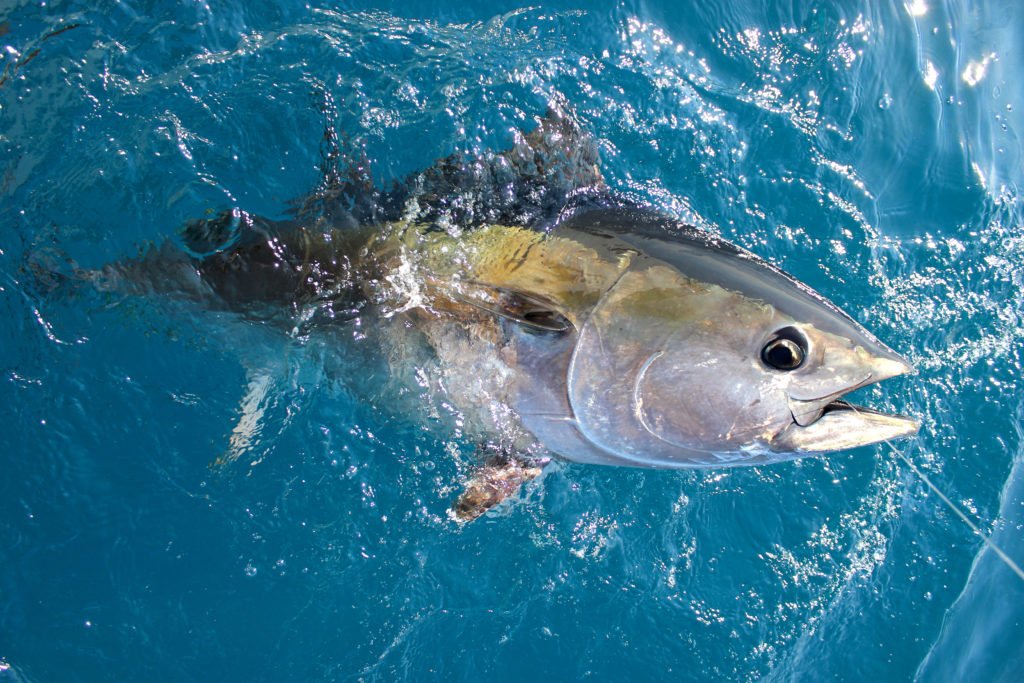
Bluefin tuna caught in the Mediterranean Sea off the French Riviera
Most fishing charters though practice catch and release. After catching the bluefin tuna and having made some pics to show home, they release the tuna in perfect conditions. Several charters even tag the fish for scientific purposes, to track their migration, feeding and spawning habits.
Biologists distinguish 3 species of Bluefin tuna: the Atlantic, Pacific and Southern Bluefin Tuna – let’s explain their habitats and their migration routes.
Atlantic Bluefin Tuna
The Atlantic Bluefin Tuna (Thunnus thynnus) is commonly referred to as the Giant Bluefin Tuna, Tunny, or Northern Bluefin Tuna. Atlantic Bluefins are native to the Western and Eastern Atlantic Ocean, as well as the Mediterranean Sea. They are now unfortunately extinct in the Black Sea. The Atlantic Bluefin are close relations of the Pacific Bluefin and the Southern Bluefin.
Atlantic Bluefins have been recorded at weights of up to 680 kg // 1500 lbs. The males of this species are known for their pinkish grey or bluish-greenish skin, with a white belly. The females of the species are blackish grey with grey and white lines on their bodies.
Where does Atlantic Bluefin Tuna spawn?
Atlantic Bluefin Tuna spawn in cool, deep water at low temperatures, with the optimal spawning period occurring from April to June. These tuna spawn in two distinct areas: one in the Western Mediterranean, near the Balearic Islands, and the other in the Gulf of Mexico. Female Bluefins have the remarkable capacity to produce up to 30 million eggs.
During early spring (March – April), the Atlantic Bluefin Tuna embarks on a migration into the Mediterranean Sea, passing through the Straits of Gibraltar. From there, they follow maritime routes along the Spanish mainland towards the Balearic Islands. This region is ideal for spawning due to the perfect combination of salinity, water temperature, and the abundance of forage fish.
To better understand the migration paths and spawning areas of Atlantic Bluefin Tuna, please refer to the accompanying map below. The map provides a visual representation of their journey from the Straits of Gibraltar to the Western Mediterranean and the Gulf of Mexico, highlighting the significant areas for spawning.
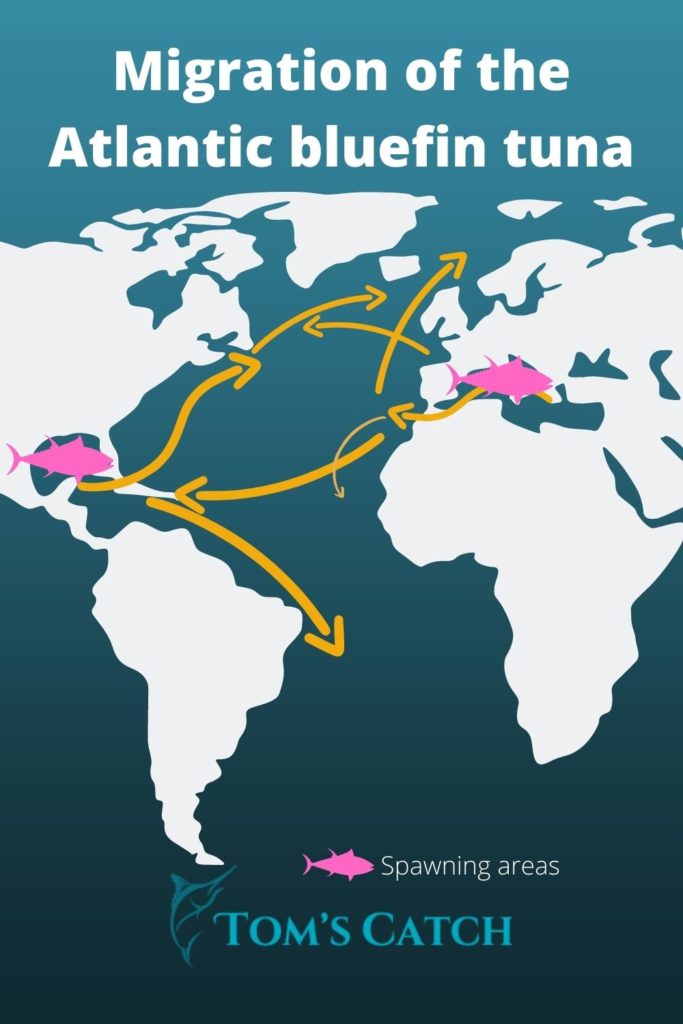
Migration and Spawning behavior of Atlantic bluefin tuna
This mapping enhances the understanding of the complex migratory behavior of Atlantic Bluefin Tuna and the importance of specific regions for their reproductive activities.
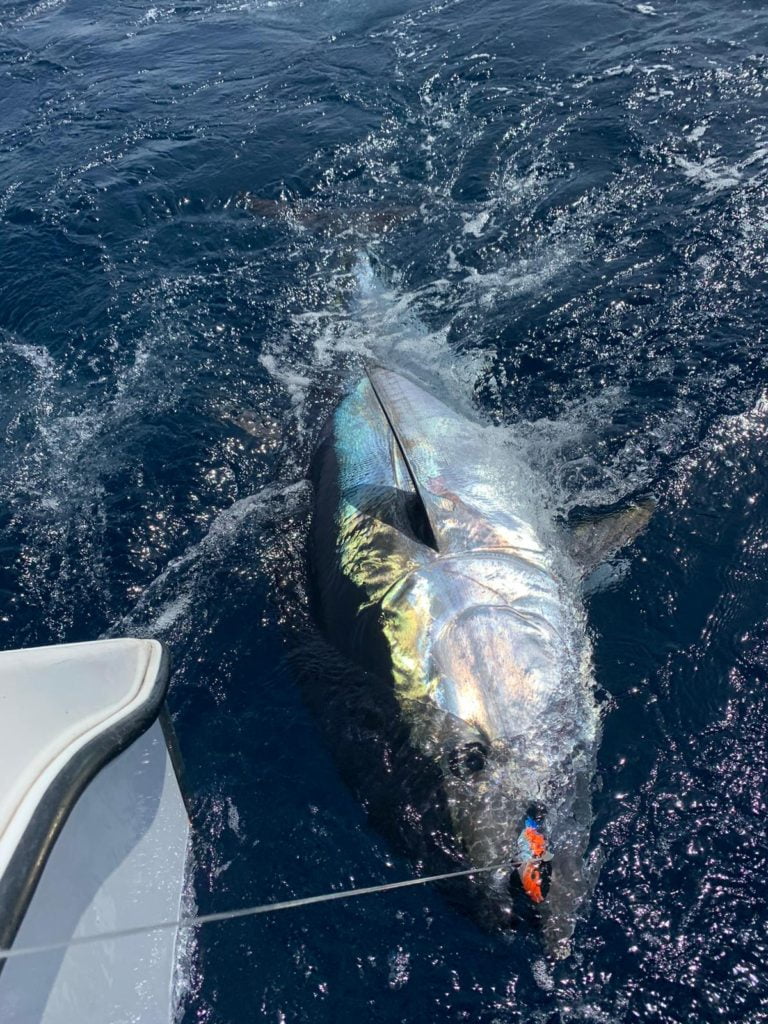
Bluefin Tuna catch & release on the Cavalier in Gran Canaria
Killer Whales, Phoenicians and the Almadraba
As the tuna swim along their migration route – and hunted by the orcas -, they get funneled into progressively smaller enclosures until they reach the central chamber. Fishermen then close off the entrance to the copo mayor, trapping the tuna inside. From there, they can be caught using smaller nets or pulled out by hand.
This traditional and sustainable fishing method has been practiced for centuries, although its use has decreased due to various factors including changes in fishing regulations and environmental concerns about overfishing.
Pacific Bluefin Tuna
The Pacific Bluefin Tuna (Thunnus orientalis) is a large and aggressive species that is found in the warm Pacific Ocean. It has been recorded at weights of up to 450 kg and 3 meters in length and can live up to 26 years old. Around 80% of commercial caught Pacific Tuna is consumed in Japan and is considered particularly suited for Sushi and Sashimi.
Where does Pacific Bluefin Tuna spawn?
Bluefin Tuna migrate from their spawning grounds in the Sea of Japan and travel over 8,000km across the Pacific Ocean to the warm waters of California. There, they spend several years feeding and growing, traveling up and down the coast between Mexico and as far north as Washington. At around the age of 6-7, many Bluefin Tuna return to the Western Pacific to spawn around the coast of Japan. Pacific Bluefins spawn in the North Western Philippine Sea and in the Sea of Japan, usually around April to August, but this is dependent on the region. Females can produce between 5 million and 25 million eggs.
For a visual representation of the extensive journey undertaken by Pacific Bluefin Tuna, please refer to the accompanying map below. The map illustrates their migration across the Pacific Ocean, feeding grounds along the California coast, and the return journey to the spawning areas in the Western Pacific.
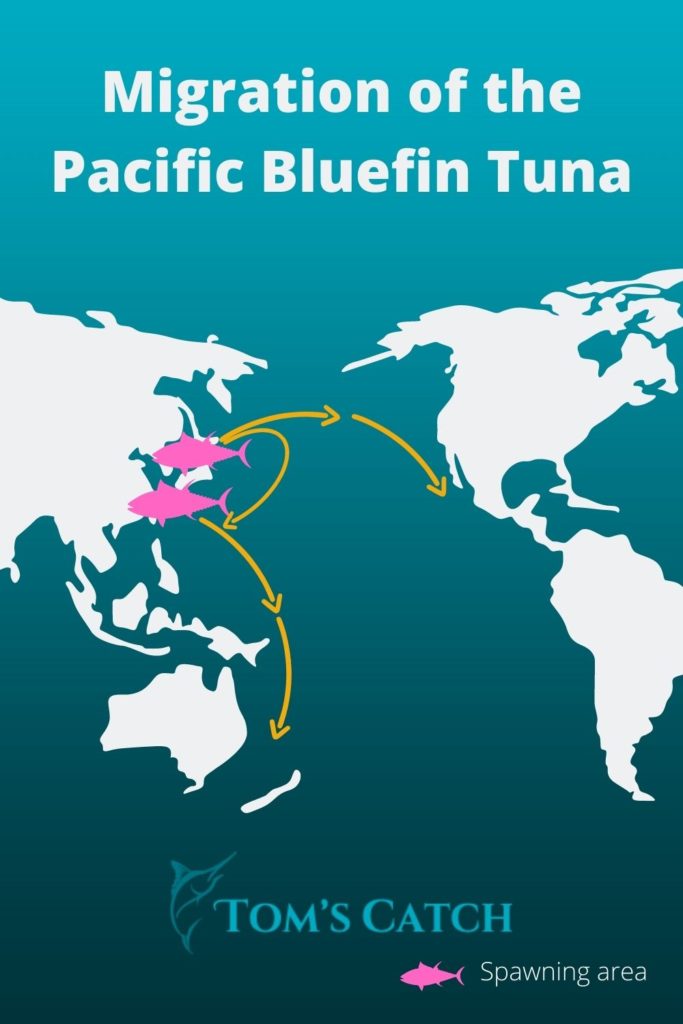
Migration and Spawning grounds of the Pacific Bluefin Tuna
This mapping provides a visual insight into the remarkable migratory patterns of Pacific Bluefin Tuna as they traverse vast distances in the Pacific Ocean, contributing to their life cycle and reproductive habits.
Southern Bluefin Tuna
Southern Bluefin Tuna (Thunnus maccoyii) is a migratory species and managed internationally. Southern Bluefins are found in the world’s waters, mostly between 30 degrees South and 50 degrees South. Southern Bluefins can grow up to around 2.5m and weigh up to 260kg. They have a lifespan of up to 40 years of age. The body of this fish is streamlined with large amounts of dorsal and anal fin rays, which are rounded and tapering. There are a few long and narrow pectoral fins near the tip and around the sides of the body, while the tail is short like that of the Blackfin Tuna.
Mapping Where Southern Bluefin Tuna Spawn?
Between September and April, Southern Bluefin Tuna travel from South Australia towards the tropical waters in the northeastern Indian Ocean south of Java. This tuna species reaches maturity at around 11‑12 years. Females can produce up to 15 million eggs. After spawning, Southern Bluefin Tuna migrate south from the spawning grounds. During the rest of the year, Southern Bluefin Tuna migrate westwards and eastwards. They move to feeding grounds southeast of South Africa and areas between New South Wales and New Zealand.
To visualize their migratory paths and feeding grounds, you can refer to the accompanying map below. The map illustrates the extensive journey of Southern Bluefin Tuna, highlighting their routes from South Australia to the Indian Ocean and their subsequent movements towards South Africa and the regions between New South Wales and New Zealand.
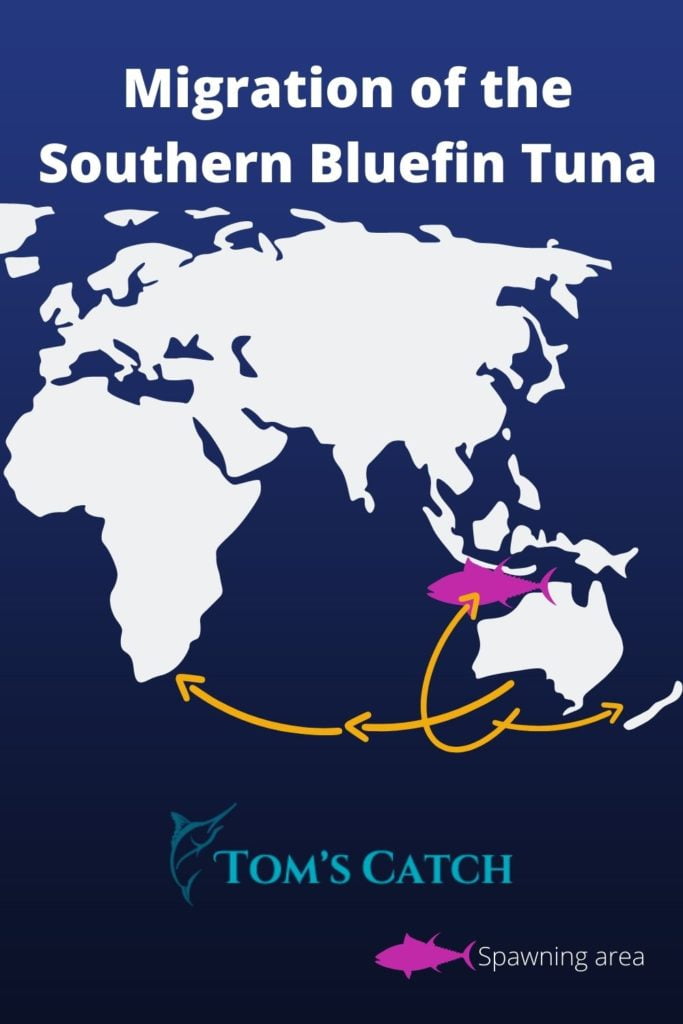
Migration and Spawning grounds of the Southern Bluefin Tuna
This mapping provides a comprehensive view of the remarkable migration patterns of Southern Bluefin Tuna throughout the year.
Additional information about bluefish tuna
Pacific bluefin tuna vs Atlantic bluefin
Let’s compare them:
| Characteristic | Pacific Bluefin Tuna | Atlantic Bluefin Tuna |
|---|---|---|
| Geographical Distribution | Warm Pacific Ocean | Western and Eastern Atlantic Ocean, Mediterranean Sea |
| Size | Up to 450 kg, 3 meters in length | Up to 680 kg, recorded weights |
| Lifespan | Up to 26 years old | Up to 40 years old |
| Consumption | Predominantly consumed in Japan | Valued for sushi in Asia |
| Spawning Grounds | Sea of Japan, migration to California | Western Mediterranean, Gulf of Mexico |
| Spawning Period | Around April to August | April to June |
| Egg Production | 5 million to 25 million eggs | Up to 30 million eggs |
| Appearance | Varies, with pinkish-grey or bluish-greenish skin in males; blackish-grey with grey and white lines in females | Pinkish grey or bluish-greenish skin in males; blackish grey with grey and white lines in females |
What is the population of bluefin tuna?
As of 2023, the bluefin tuna population is reported to be 1.6 million.
Do tuna fish die if they stop swimming?
Yes, tuna fish need to keep swimming to extract oxygen from water through their gills. If they stop swimming, they may suffocate due to a lack of oxygen intake.
How fast does bluefin tuna grow?
Bluefin tuna can grow at rates of 1 to 4 inches per month in their first year, but growth slows down as they age.
How fast does bluefin tuna swim?
Bluefin tuna are known for their remarkable speed and agility. They can swim at speeds of up to 40 miles per hour (64 kilometers per hour).
Where are bluefin tuna located?
Bluefin tuna are found in various oceans around the world, including the Atlantic and Pacific. Specific locations can include the waters off Cabo San Lucas in Mexico, where tuna fishing is popular. Their distribution can cover a wide range, and they may migrate over long distances during different seasons.









